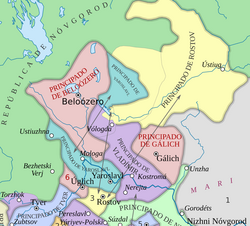
Back Běloozerské knížectví Czech Principado de Beloózero Spanish Principauté de Beloozero French ベロオーゼロ公国 Japanese ბელოოზეროს სამთავრო Georgian Vorstendom Belozersk Dutch Белозерское княжество Russian Білозерське князівство Ukrainian Thân vương quốc Beloozero Vietnamese
60°00′N 37°50′E / 60.000°N 37.833°E
Principality of Beloozero Белозерское княжество | |||||||||
|---|---|---|---|---|---|---|---|---|---|
| 1238–1486 | |||||||||
 Principality of Beloozero (14th century) | |||||||||
| Status | Principality | ||||||||
| Capital | Beloozero | ||||||||
| Common languages | Russian | ||||||||
| Religion | Russian Orthodoxy | ||||||||
| Government | Monarchy | ||||||||
| Prince of Beloozero | |||||||||
• 1238–1278 | Gleb Vasilkovich (first) | ||||||||
| Historical era | Middle Ages | ||||||||
• Established | 1238 | ||||||||
• Annexed to Moscow | 1486 | ||||||||
| |||||||||
| Today part of | Russia | ||||||||
The Principality of Beloozero (Russian: Белозерское княжество) was a Russian principality which flourished between the 13th and 15th centuries in the Russian North. In terms of the current administrative division of Russia, the principality was located in the west of Vologda Oblast, around the south of Lake Beloye.
Its capital was Beloozero (now Belozersk), one of the five original towns mentioned in the Primary Chronicle. It was closely associated with Rostov until it became independent in 1238 during the Mongol invasions. Dmitry Donskoy secured control over Beloozero and passed it to his descendants; it was formally annexed to Moscow by Ivan III.[1]
- ^ Langer, Lawrence N. (2021). Historical dictionary of medieval Russia (Second ed.). Lanham. p. 28. ISBN 9781538119426.
{{cite book}}: CS1 maint: location missing publisher (link)
